During the beer brewing process, nitrogen purging in filler bowls primarily serves to displace oxygen and create an oxygen-free environment. This is critical for increasing the integrity of the packaging. Oxygen can have a damaging effect on beer quality, causing off-flavours, staling, and oxidation. Breweries use nitrogen to avoid these problems while maintaining the taste and aroma of their beer. Aside from the cost savings of producing nitrogen on-site, this method also aligns with sustainability goals and provides a practical alternative to purchasing CO2 from third-party suppliers, making it an important choice for breweries. Let’s delve deeper into the subject.
Challenges with packaging integrity
Breweries face a number of packaging integrity issues, the most serious of which is oxygen exposure. Off-flavours, staling, and oxidation can all be caused by oxygen, negatively impacting the taste and aroma of the beer. Nitrogen purging is a technique for dealing with these issues by displacing oxygen in filler bowls and creating an oxygen-free environment.
The achievement of very low oxygen levels, specifically in the range of 10 ppb to 25 ppb, which is thought to be optimal for beer packaging, is a significant challenge. While nitrogen generators can reduce oxygen levels to 10 ppm (parts per million), they cannot typically achieve extremely low ppb levels. Brewers frequently use CO2 and nitrogen blends to improve purity, but even with this method, reaching the 10-25 ppb range can be difficult.
And how does nitrogen purging aid in the prevention of oxygen exposure?
Because nitrogen is an inert gas, it does not react with beer, making it an excellent choice for creating an oxygen-free environment. Despite the fact that nitrogen is less dense than CO2, it is still effective at displacing oxygen. Although more nitrogen is required to purge a filler bowl than CO2, it forms a protective barrier that pushes oxygen out, reducing the chances of oxidation. Nitrogen purging, in essence, serves as a reliable safeguard, preserving beer freshness and quality during the packaging process.
What are some of the advantages of this procedure?
Purging in filler bowls does not directly improve beer freshness and flavour from a technical standpoint. The main purpose of this procedure is to remove oxygen, which can be a source of deterioration. Nitrogen is an inert gas that displaces oxygen, but it does not actively contribute to flavour preservation or enhancement. Instead, it serves to preserve the status quo by preventing the introduction of harmful oxygen-related changes in the beer. Ultimately, the primary advantage of nitrogen purging is that the beer’s existing flavour and freshness are preserved rather than actively enhanced.
Preventing Oxygen Exposure: The Benefits of Nitrogen Purging in Filler Bowls
Oxygen exposure poses significant risks to beer quality, resulting in a variety of negative effects:

1. Oxidation: Beer can oxidise when exposed to oxygen, resulting in off-flavours and a “cardboard” taste. This is undesirable because it alters the intended flavour profile of the beer.
2. Staling: Oxygen can hasten beer staling, causing it to lose its freshness and develop a dull or stale flavour. This has an impact on the overall flavour and aroma of the beer.
3. Aroma Changes: Oxygen exposure can have a negative impact on the aroma of beer, resulting in bouquet changes and potentially unpleasant odours.
Nitrogen’s beneficial effects on quality and preservation
Nitrogen purging prevents oxidation, staling, and aroma changes by reducing the beer’s exposure to oxygen during packaging, thereby preserving the intended beer quality and flavour.
It is also worth noting that it can have an effect on the shelf life of beer:
Nitrogen purging in filler bowls has a significant impact on beer shelf life. Here’s how it contributes to the beer’s longevity:
1. Oxidation Prevention: As previously stated, one of the primary functions of nitrogen purging is to displace oxygen in the filler bowls. Beer degradation and spoilage are heavily influenced by oxygen. Nitrogen purging reduces oxidation of beer by creating an oxygen-free environment, which is a major factor in reducing its shelf life.
2. Quality Preservation: Exposure to oxygen can cause off-flavours and aroma changes in beer, making it less appealing over time . Nitrogen purging helps preserve the beer’s quality and taste, ensuring that it remains consistent and appealing for an extended period.
3. Reducing Microbial Growth: While less emphasized in this context, an oxygen-free environment also limits the potential for microbial growth, which can lead to spoilage. This further contributes to prolonging the beer’s shelf life.
Extending Shelf Life: Nitrogen Purging and Its Impact on Beer Stability
To ensure optimal beer stability, breweries should pay close attention to nitrogen purity and flow rates during the purging process:
1. Nitrogen Purity: As previously stated, nitrogen purity is critical. Breweries should aim for nitrogen purity levels of 99.999% (5.0-grade nitrogen) or higher to maintain optimal beer stability. High-purity nitrogen helps to reduce the introduction of impurities that could affect the quality of the beer.
2. Flow Rates: The nitrogen flow rates into the filler bowls must be precisely controlled. It’s critical to strike a balance between effective purging and not interfering with the brewing or packaging processes. A fast flow may agitate the beer or cause turbulence, whereas a slow flow may be insufficient for effective purging.
3.Monitoring and Control: Breweries should invest in proper monitoring and control systems to ensure that nitrogen purity and flow rates remain within the desired parameters. Automated systems can help to maintain consistency and reduce error margins.

4. System Maintenance: It is critical to maintain equipment and nitrogen supply systems on a regular basis to ensure that nitrogen purity is consistently met. Maintenance schedules and procedures should be well documented and strictly adhered to.
5. Quality Assurance Testing: Implementing quality assurance measures, such as testing the purity of the nitrogen source, can help confirm that the desired levels are met. Testing the final packaged beer on a regular basis can also ensure that the purging process is effectively maintaining beer stability.
Are there any industry standards that breweries should adhere to?
Breweries need to comply with safety regulations regarding the handling of gases, including nitrogen. These regulations often focus on gas storage, transportation, and worker safety. Ensuring that the nitrogen supply and purge system is installed and maintained safely is crucial.
Closing words
In conclusion, the use of nitrogen purging in filler bowls is a valuable technique in the brewing industry, contributing significantly to beer packaging integrity and longevity. It offers a shield against the detrimental effects of oxygen exposure, preserves the beer’s freshness, and helps maintain its quality and flavour. While nitrogen purging may not actively enhance flavour, its role in creating an oxygen-free environment is paramount for safeguarding the intended taste and aroma.
In an industry where the quality of the product is paramount, nitrogen purging serves as a crucial tool to maintain the excellence and reliability of beer. From the moment it leaves the brewery to the enjoyment of the consumer’s glass.
Continue your read here
